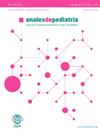Diseño y validación de un cuestionario sobre hábitos, salud y ejercicio en el uso de portabebés
IF 1.5
4区 医学
Q2 PEDIATRICS
引用次数: 0
Abstract
Introduction
Understanding the characteristics and implications of the use of baby carriers can help health care providers understand the habits of their patients and provide guidance to improve quality of life in both children and caregivers. The aim of our study was to design and validate the first self-administered questionnaire to assess babywearing habits and their impact on health and physical activity as a means to monitor musculoskeletal complaints in caregivers.
Material and methods
Three hundred fifty individuals who currently used or had used baby carrying systems in the last 10 years completed the questionnaire, which was previously subject to a pilot study in a panel of experts. We used exploratory factor analysis to assess the validity of the internal structure of the questionnaire. The Cronbach α coefficient was used to assess reliability. We used varimax rotation to improve the interpretation of the extracted factors.
Results
The factor analysis showed that the questionnaire is appropriate for measuring the dimensions or carriage factors established a priori. It extracted 3 factors each for the constructs of duration and weight of carriage, motivation, exercise habits and effects on infant health and 2 factors for caregiver pain that explained between 55% and 72% of the variance in each construct. The Cronbach α values were greater than 0.5.
Conclusions
The results support the validity of the questionnaire and demonstrate that it is useful for its intended purpose.

设计和验证婴儿背带习惯、健康和锻炼问卷
了解婴儿背带使用的特点和影响可以帮助卫生保健提供者了解患者的习惯,并为改善儿童和照顾者的生活质量提供指导。我们研究的目的是设计和验证第一份自我管理的问卷,以评估婴儿穿着习惯及其对健康和身体活动的影响,作为监测照顾者肌肉骨骼抱怨的一种手段。材料和方法350名在过去10年中使用或曾经使用过婴儿携带系统的人完成了问卷调查,该问卷之前是由一个专家小组进行的试点研究。我们采用探索性因子分析来评估问卷内部结构的效度。采用Cronbach α系数评价信度。我们使用变差旋转来改善提取因子的解释。结果因子分析表明,该问卷适合测量先验建立的维度或承载因素。它提取了3个因素,每个因素是持续时间和运输重量,动机,运动习惯和对婴儿健康的影响,还有2个因素是照顾者疼痛,这解释了每个结构中55%到72%的差异。Cronbach α值均大于0.5。结论:结果支持问卷的有效性,并证明它对其预期目的是有用的。
本文章由计算机程序翻译,如有差异,请以英文原文为准。
求助全文
约1分钟内获得全文
求助全文
来源期刊

Anales de pediatria
医学-小儿科
CiteScore
2.10
自引率
4.80%
发文量
155
审稿时长
44 days
期刊介绍:
La Asociación Española de Pediatría tiene como uno de sus objetivos principales la difusión de información científica rigurosa y actualizada sobre las distintas áreas de la pediatría. Anales de Pediatría es el Órgano de Expresión Científica de la Asociación y constituye el vehículo a través del cual se comunican los asociados. Publica trabajos originales sobre investigación clínica en pediatría procedentes de España y países latinoamericanos, así como artículos de revisión elaborados por los mejores profesionales de cada especialidad, las comunicaciones del congreso anual y los libros de actas de la Asociación, y guías de actuación elaboradas por las diferentes Sociedades/Secciones Especializadas integradas en la Asociación Española de Pediatría.
 求助内容:
求助内容: 应助结果提醒方式:
应助结果提醒方式:


